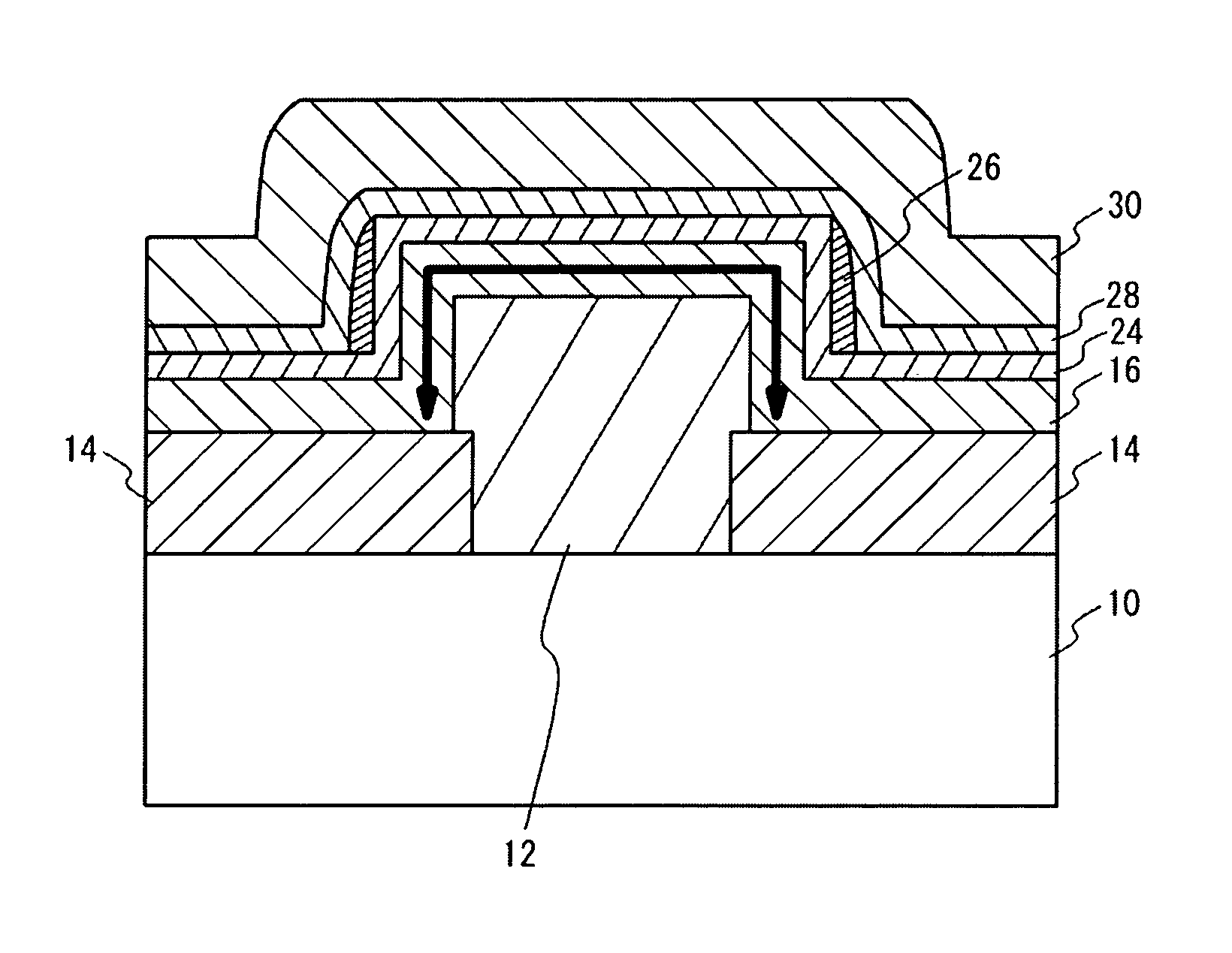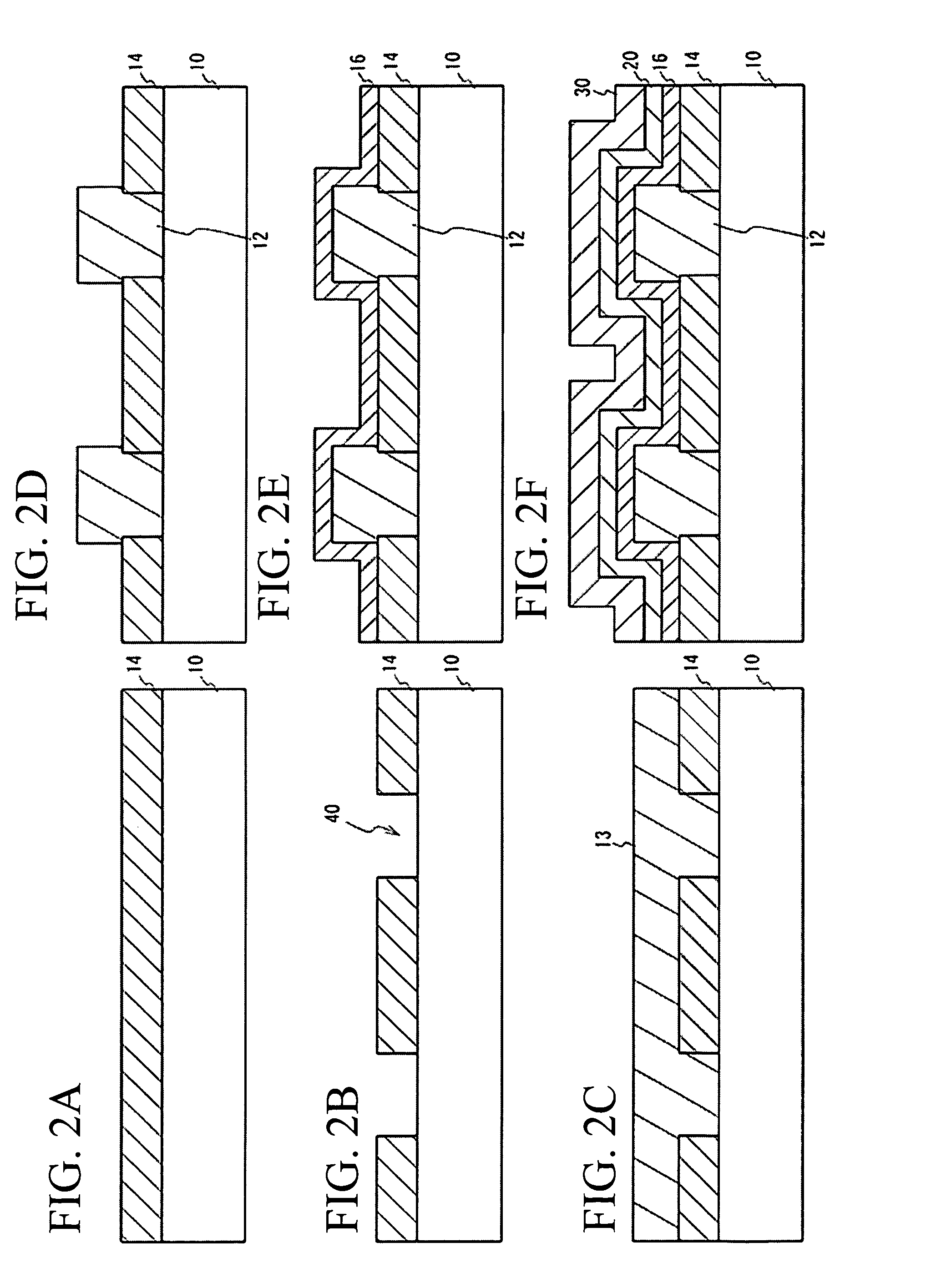Convex shaped thin-film transistor device
a thin-film transistor and convex technology, applied in semiconductor devices, semiconductor/solid-state device details, radiation controlled devices, etc., can solve the problems of limiting the amount of storage capacity and density of each memory cell, and difficulty in so as to achieve easy higher storage capacity and density, the effect of shortening the distance between the bit lines
- Summary
- Abstract
- Description
- Claims
- Application Information
AI Technical Summary
Benefits of technology
Problems solved by technology
Method used
Image
Examples
first embodiment
[0040]FIG. 2A through FIG. 2F are cross-sectional views illustrating the procedures for manufacturing the flash memory in accordance with the As shown in FIG. 2A, an n-type polysilicon layer 14 is formed on a substrate 10 such as a quartz substrate, a sapphire substrate, a glass substrate, or a silicon substrate, by chemical vapor deposition (CVD). As shown in FIG. 2B, openings 40 are formed in the polysilicon layer 14 on the substrate 10 by an exposure technique and an etching technique. Through this procedure, the polysilicon layer 14 is turned into bit lines 14. The bit lines 14 are designed to have the same resistivity as the resistivity of the bit lines of a conventional flash memory. As shown in FIG. 2C, a layer 13 to be an insulating layer is formed on and between the bit lines 14. This layer 13 is formed from a silicon oxide film, for example, by CVD.
[0041]As shown in FIG. 2D, etching is performed on predetermined regions of the layer 13 by an exposure technique and an etch...
sixth embodiment
[0053]FIG. 10A through FIG. 10F are cross-sectional views illustrating the procedures for manufacturing the flash memory in accordance with the As shown in FIG. 10A, the substrate 10 such as a quartz substrate, a sapphire substrate, a glass substrate, or a silicon substrate is prepared. As shown in FIG. 10B, etching is performed on predetermined regions of the substrate 10 by an exposure technique and an etching technique, so as to form the insulating layers 12c each having a protruding form on the substrate 10. Although the insulating layers 12c are made of the same material as the substrate 10, the insulating layers 12c are indicated by hatched lines in FIG. 10B through 10F. As shown in FIG. 10C, a layer 17 to be channel layers is formed on the substrate 10 with an n-type polysilicon layer having boron added thereto. The layer 17 covers the insulating layers 12.
[0054]As shown in FIG. 10D, arsenic ions are vertically injected into the portions of the layer 17 to be the channel lay...
eighth embodiment
[0060]the present invention is an example case where the substrate has a groove between first bit lines, and an insulating layer is formed in the groove. FIG. 13 is a cross-sectional view of a flash memory in accordance with the eighth embodiment. A groove 11 is formed at the portion of a substrate 10a located between bit lines 14, and the groove 11 is filled with an insulating layer 12d. The other aspects of this structure are the same as those of the sixth embodiment shown in FIG. 9B. The same components as those shown in FIG. 9B are denoted by the same reference numerals as those in FIG. 9B, and explanation of them is omitted herein.
[0061]In the eighth embodiment, the insulating layer 12d is buried at the portion of the substrate 10a located between the bit lines 14. Accordingly, even if the distance between the bit lines 14 is made smaller, the path of a substrate current (indicated by the dotted arrows in FIG. 13) flowing in the substrate 10a can be lengthened between the bit l...
PUM
 Login to View More
Login to View More Abstract
Description
Claims
Application Information
 Login to View More
Login to View More - R&D
- Intellectual Property
- Life Sciences
- Materials
- Tech Scout
- Unparalleled Data Quality
- Higher Quality Content
- 60% Fewer Hallucinations
Browse by: Latest US Patents, China's latest patents, Technical Efficacy Thesaurus, Application Domain, Technology Topic, Popular Technical Reports.
© 2025 PatSnap. All rights reserved.Legal|Privacy policy|Modern Slavery Act Transparency Statement|Sitemap|About US| Contact US: help@patsnap.com



